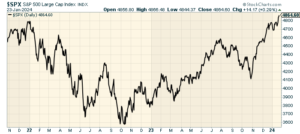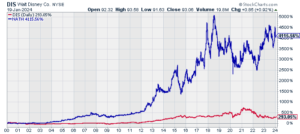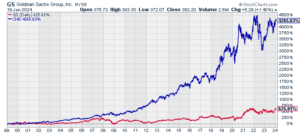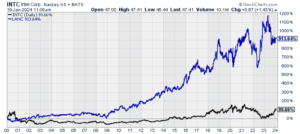CWS Market Review – January 23, 2024
(This is the free version of CWS Market Review. If you like what you see, then please sign up for the premium newsletter for $20 per month or $200 for the whole year. If you sign up today, you can see our two reports, “Your Handy Guide to Stock Orders” and “How Not to Get Screwed on Your Mortgage.”)
A New All-Time High
On Friday, the stock market closed at a new all-time high. The S&P 500 had gone slightly more than two years, or 512 trading days to be precise, without making a new high.
From high to low, the market had lost more than 25%. It takes a 33% gain to wipe out a 25% loss, but we did it. The drop took nine months while the rally took 15 months.
I don’t want you to think I’m an uncritical cheerleader for the bulls. Of course, if we were to include inflation, then we’re still well short of a new high. Still, in nominal terms, we’ve never been higher.
Take it away, Rita.
The stock market closed even higher on Monday and again on Tuesday. This brings up an interesting subject which is, how well does the market do when it’s at an all-time high?
You might think the market hasn’t done well since, by definition, the market’s never been higher than it is at an all-time high. Also, every bear market starts at a new high. Of course, that’s not a coincidence. Axiomatically, shouldn’t an all-time high be a bad time to invest?
The answer is no. In fact, the market has performed quite well at its all-time high. This gets to an important fact about the stock market and investing: the real money is made during relatively uninteresting markets.
I recently ran the numbers. Since 1957, the S&P 500 has made a new all-time high more than 1,100 times. (I could even be sneaky with the data because the market didn’t pass its 1929 high for 25 years, but I purposely started after that.)
If we were to invest in only those days following a new high, then the market has risen at an average annualized rate of just over 15%. When the market hasn’t been at an all-time high, it’s gained an average of just 6.7%. The market has performed more than twice as well when it’s been at a new all-time high compared to when it hasn’t been. Buy high and sell even higher.
To me the arresting fact isn’t how well the market has done at its high but rather how calm it’s been. The volatility is about 36% less than normal. You rarely see a big day after a new high. Most of the big drops don’t come right at the new high. Instead, the big drops come after a slide.
Since 1957, the S&P 500 has risen by more than 2% following a new high just three times. The normal market sees 2% up days more than four times more frequently. Generally speaking, when the market goes down, volatility goes up. The largest rally off a new high came on January 6, 1999 when the S&P 500 gained 2.21%. That’s a nice gain but compared with other big days, it’s barely a bump.
I’ll give you another example of how boring is good. Low volatility days are much better for the market. If we take all of the daily returns for the last 60 years and divide them into two buckets, the first bucket is days when the market moved up or down by more than 1.2%, and the other bucket is when the market moved up or down by less than 1.2%.
The combined daily returns of the greater than 1.2% days comes to nothing (actually, a small loss). The stock market’s entire gain for the last several decades has come on low volatility days. The simple fact is that most of the big days have been bad days, or they’ve been good days during lousy markets. As the great Jesse Livermore said, “It never was my thinking that made the big money for me. It always was my sitting.”
Don’t Look Past Boring Stocks
Not only are boring markets good, but so are many boring stocks. For some reason, many investors think that a company has to be reinventing the world to be a good investment. That’s not the case. There are many completely boring companies that have been wonderful investments. Many of the worst investments have been in fast-growing sectors.
Here are a few charts you might enjoy:
The red line (Disney) is perhaps the most important name in entertainment with unparalleled intellectual property. The blue line is a hot dog stand.
Goldman Sachs (red line) is one of the largest and most powerful financial institutions in the world. The blue line makes condoms and baking soda.
Intel (black line) is one of the world’s largest semiconductor chip manufacturers. The blue line makes croutons.
Of course, I’m exaggerating, but the underlying point still stands. There’s a lot of money to be made from a dull or uninteresting company. Two boring stocks that I like at the moment are Amphenol (APH) and Miller Industries (MLR)
Q4 Earnings Season so Far
We’re still early in the Q4 earnings season, but I wanted to see how it looks so far. Right now, earnings for the S&P 500 are tracking for an increase of 0.71% compared with last year. That’s a little lower than where it had been. One month ago, we had been expecting growth of 2.24%.
So far, 76.5% of companies have beaten their earnings estimates while 59.6% have beaten on sales. Just under half, or 47.1%, have beaten on both sales and earnings.
For all of 2023, the S&P 500 is on pace to post earnings of $216.85. That means the market is going for about 22 times trailing earnings. That’s elevated but not worrying.
Generally, lower interest rates lead to higher earnings multiples. It looks like rates will be going down this year but not as quickly as previously assumed.
The Federal Reserve starts its first meeting of the year one week from today. The Fed’s policy statement will be due out next Wednesday. It’s widely believed that the Fed won’t make any changes to interest rates at this meeting, but that may change very soon.
For its March meeting, futures traders are nearly evenly divided on the need for a rate cut. For now, the markets are leaning towards the Fed keeping rates unchanged in March. For the May meeting, however, the market places the odds of a rate cut at close to 90%. The Fed hasn’t lowered interest rates in nearly four years.
The market was shaken by the recent comments from Fed Governor Christopher Waller. He said that rate cuts are coming this year, but the market should be cautious in its expectations. The futures market expects the Fed to cut rates by 1.5% this year. That could be too high.
Not that long ago, many folks on Wall Street believed the economy would be in recession by now, but the recent economic news has been somewhat good. Last week’s report on initial jobless claims was quite good. The retail sales report came in above expectations. Homebuilder confidence surged and consumer confidence is at its highest level since July 2021.
By no means do I intend to gloss over the weaknesses in the economy. The housing market is in rough shape and credit-card delinquencies are at some of their worst levels in years. Of course, the economic outlook can change very quickly. Rates will probably come down this year, but the market needs to temper its expectations.
That’s all for now. I’ll have more for you in the next issue of CWS Market Review.
– Eddy
P.S. If you want more info on our ETF, you can check out the ETF’s website.
Posted by Eddy Elfenbein on January 23rd, 2024 at 6:29 pm
The information in this blog post represents my own opinions and does not contain a recommendation for any particular security or investment. I or my affiliates may hold positions or other interests in securities mentioned in the Blog, please see my Disclaimer page for my full disclaimer.
-
-
Archives
- June 2025
- May 2025
- April 2025
- March 2025
- February 2025
- January 2025
- December 2024
- November 2024
- October 2024
- September 2024
- August 2024
- July 2024
- June 2024
- May 2024
- April 2024
- March 2024
- February 2024
- January 2024
- December 2023
- November 2023
- October 2023
- September 2023
- August 2023
- July 2023
- June 2023
- May 2023
- April 2023
- March 2023
- February 2023
- January 2023
- December 2022
- November 2022
- October 2022
- September 2022
- August 2022
- July 2022
- June 2022
- May 2022
- April 2022
- March 2022
- February 2022
- January 2022
- December 2021
- November 2021
- October 2021
- September 2021
- August 2021
- July 2021
- June 2021
- May 2021
- April 2021
- March 2021
- February 2021
- January 2021
- December 2020
- November 2020
- October 2020
- September 2020
- August 2020
- July 2020
- June 2020
- May 2020
- April 2020
- March 2020
- February 2020
- January 2020
- December 2019
- November 2019
- October 2019
- September 2019
- August 2019
- July 2019
- June 2019
- May 2019
- April 2019
- March 2019
- February 2019
- January 2019
- December 2018
- November 2018
- October 2018
- September 2018
- August 2018
- July 2018
- June 2018
- May 2018
- April 2018
- March 2018
- February 2018
- January 2018
- December 2017
- November 2017
- October 2017
- September 2017
- August 2017
- July 2017
- June 2017
- May 2017
- April 2017
- March 2017
- February 2017
- January 2017
- December 2016
- November 2016
- October 2016
- September 2016
- August 2016
- July 2016
- June 2016
- May 2016
- April 2016
- March 2016
- February 2016
- January 2016
- December 2015
- November 2015
- October 2015
- September 2015
- August 2015
- July 2015
- June 2015
- May 2015
- April 2015
- March 2015
- February 2015
- January 2015
- December 2014
- November 2014
- October 2014
- September 2014
- August 2014
- July 2014
- June 2014
- May 2014
- April 2014
- March 2014
- February 2014
- January 2014
- December 2013
- November 2013
- October 2013
- September 2013
- August 2013
- July 2013
- June 2013
- May 2013
- April 2013
- March 2013
- February 2013
- January 2013
- December 2012
- November 2012
- October 2012
- September 2012
- August 2012
- July 2012
- June 2012
- May 2012
- April 2012
- March 2012
- February 2012
- January 2012
- December 2011
- November 2011
- October 2011
- September 2011
- August 2011
- July 2011
- June 2011
- May 2011
- April 2011
- March 2011
- February 2011
- January 2011
- December 2010
- November 2010
- October 2010
- September 2010
- August 2010
- July 2010
- June 2010
- May 2010
- April 2010
- March 2010
- February 2010
- January 2010
- December 2009
- November 2009
- October 2009
- September 2009
- August 2009
- July 2009
- June 2009
- May 2009
- April 2009
- March 2009
- February 2009
- January 2009
- December 2008
- November 2008
- October 2008
- September 2008
- August 2008
- July 2008
- June 2008
- May 2008
- April 2008
- March 2008
- February 2008
- January 2008
- December 2007
- November 2007
- October 2007
- September 2007
- August 2007
- July 2007
- June 2007
- May 2007
- April 2007
- March 2007
- February 2007
- January 2007
- December 2006
- November 2006
- October 2006
- September 2006
- August 2006
- July 2006
- June 2006
- May 2006
- April 2006
- March 2006
- February 2006
- January 2006
- December 2005
- November 2005
- October 2005
- September 2005
- August 2005
- July 2005




 Eddy Elfenbein is a Washington, DC-based speaker, portfolio manager and editor of the blog Crossing Wall Street. His
Eddy Elfenbein is a Washington, DC-based speaker, portfolio manager and editor of the blog Crossing Wall Street. His